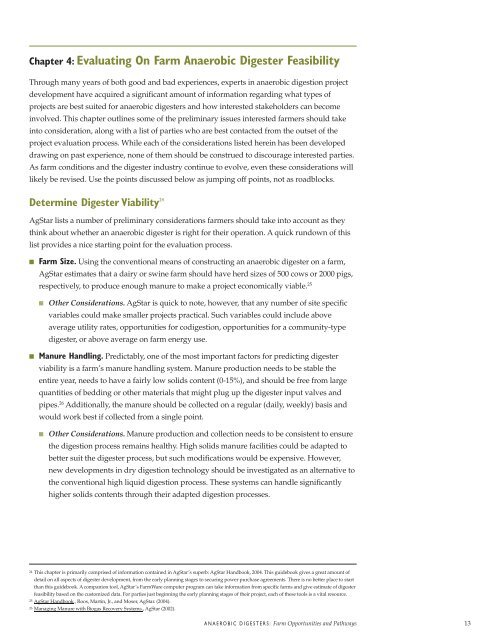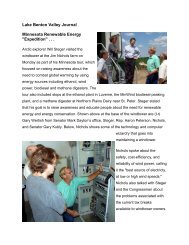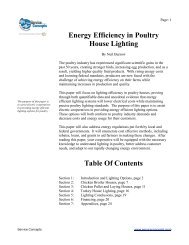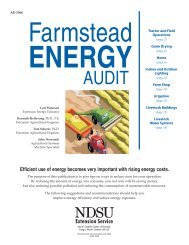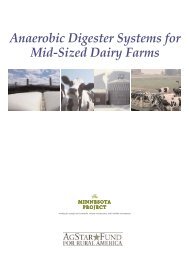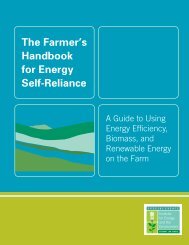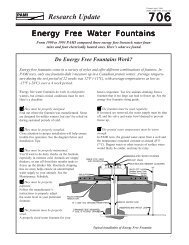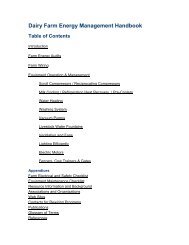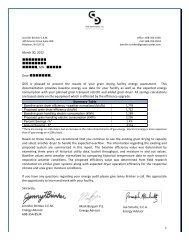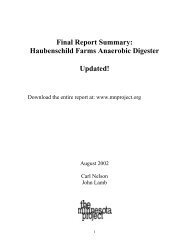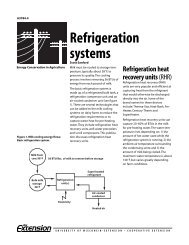Anaerobic Digesters - The Minnesota Project
Anaerobic Digesters - The Minnesota Project
Anaerobic Digesters - The Minnesota Project
You also want an ePaper? Increase the reach of your titles
YUMPU automatically turns print PDFs into web optimized ePapers that Google loves.
Chapter 4: Evaluating On Farm <strong>Anaerobic</strong> Digester Feasibility<br />
Through many years of both good and bad experiences, experts in anaerobic digestion project<br />
development have acquired a significant amount of information regarding what types of<br />
projects are best suited for anaerobic digesters and how interested stakeholders can become<br />
involved. This chapter outlines some of the preliminary issues interested farmers should take<br />
into consideration, along with a list of parties who are best contacted from the outset of the<br />
project evaluation process. While each of the considerations listed herein has been developed<br />
drawing on past experience, none of them should be construed to discourage interested parties.<br />
As farm conditions and the digester industry continue to evolve, even these considerations will<br />
likely be revised. Use the points discussed below as jumping off points, not as roadblocks.<br />
Determine Digester Viability 24<br />
AgStar lists a number of preliminary considerations farmers should take into account as they<br />
think about whether an anaerobic digester is right for their operation. A quick rundown of this<br />
list provides a nice starting point for the evaluation process.<br />
■ Farm Size. Using the conventional means of constructing an anaerobic digester on a farm,<br />
AgStar estimates that a dairy or swine farm should have herd sizes of 500 cows or 2000 pigs,<br />
respectively, to produce enough manure to make a project economically viable. 25<br />
■ Other Considerations. AgStar is quick to note, however, that any number of site specific<br />
variables could make smaller projects practical. Such variables could include above<br />
average utility rates, opportunities for codigestion, opportunities for a community-type<br />
digester, or above average on farm energy use.<br />
■ Manure Handling. Predictably, one of the most important factors for predicting digester<br />
viability is a farm’s manure handling system. Manure production needs to be stable the<br />
entire year, needs to have a fairly low solids content (0-15%), and should be free from large<br />
quantities of bedding or other materials that might plug up the digester input valves and<br />
pipes. 26 Additionally, the manure should be collected on a regular (daily, weekly) basis and<br />
would work best if collected from a single point.<br />
■ Other Considerations. Manure production and collection needs to be consistent to ensure<br />
the digestion process remains healthy. High solids manure facilities could be adapted to<br />
better suit the digester process, but such modifications would be expensive. However,<br />
new developments in dry digestion technology should be investigated as an alternative to<br />
the conventional high liquid digestion process. <strong>The</strong>se systems can handle significantly<br />
higher solids contents through their adapted digestion processes.<br />
24 This chapter is primarily comprised of information contained in AgStar’s superb: AgStar Handbook, 2004. This guidebook gives a great amount of<br />
detail on all aspects of digester development, from the early planning stages to securing power purchase agreements. <strong>The</strong>re is no better place to start<br />
than this guidebook. A companion tool, AgStar’s FarmWare computer program can take information from specific farms and give estimate of digester<br />
feasibility based on the customized data. For parties just beginning the early planning stages of their project, each of these tools is a vital resource.<br />
25 AgStar Handbook., Roos, Martin, Jr., and Moser, AgStar. (2004).<br />
26 Managing Manure with Biogas Recovery Systems., AgStar (2002).<br />
ANAEROBIC DIGESTERS: Farm Opportunities and Pathways 13


